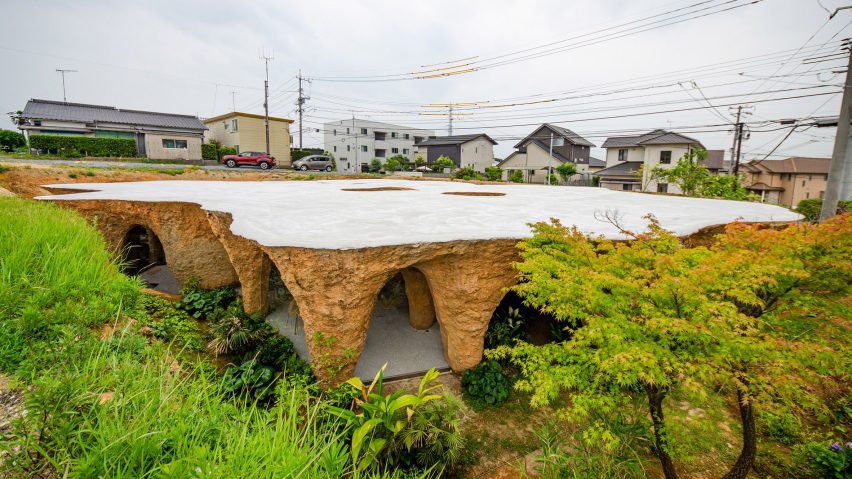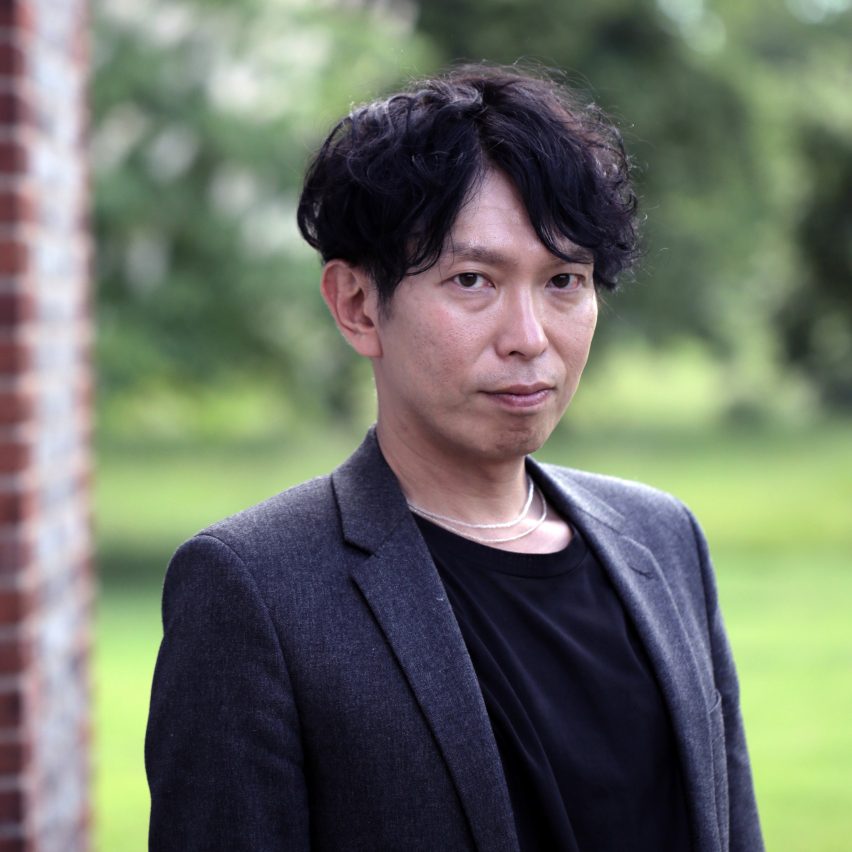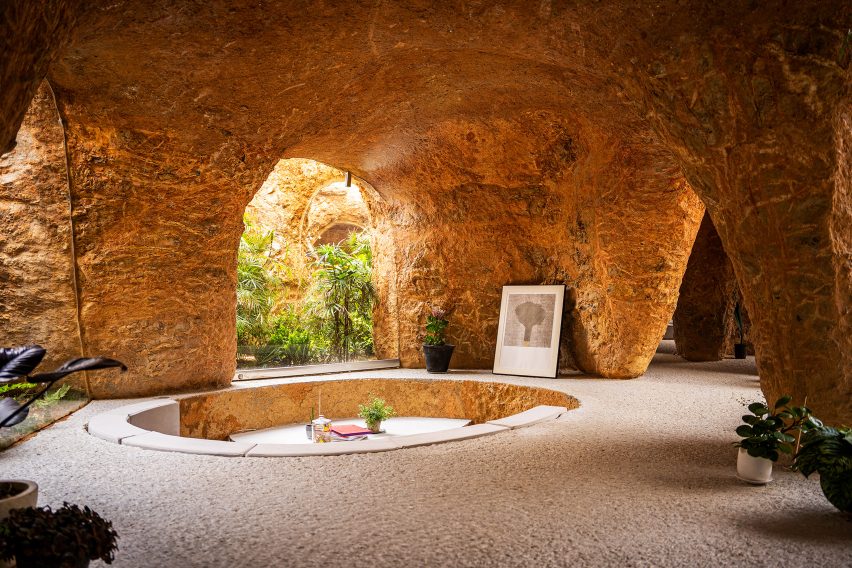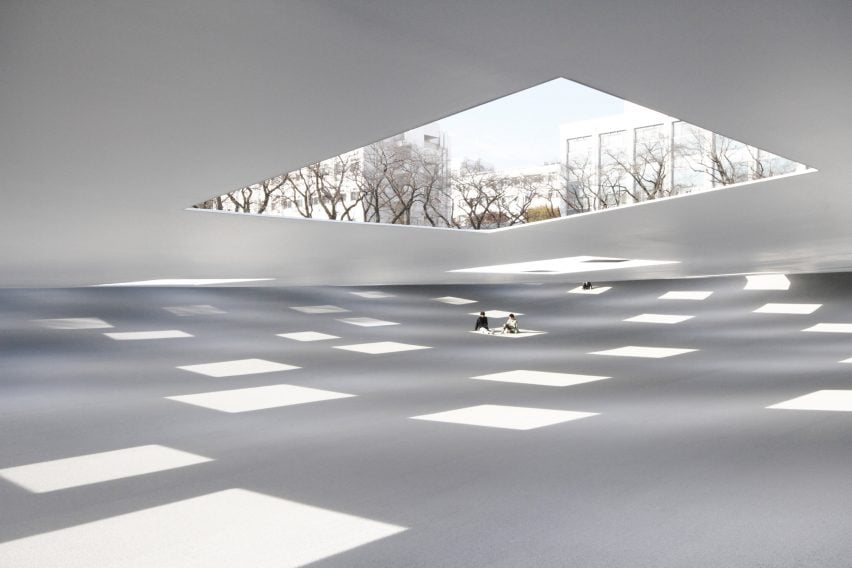
"I don't want to make crazy buildings" says Junya Ishigami
Known for a string of boundary-pushing projects, Japanese architect Junya Ishigami discusses his unusual approach to designing buildings in this exclusive interview.
Ishigami's surreal work often challenges fundamental ideas of what a building is – such as his mud-covered underground house and restaurant in Ube, which was one of the most popular projects published on Dezeen last year.
His other projects include a vast, sloping plaza covered by a chequered roof for the Kanagawa Institute of Technology and, more recently, a kilometre-long visitors' centre in China that appears to emerge eerily from a lake.
"We have to invent a lot, I think"
Delivering a keynote at the In Focus: Radical Repair conference hosted by The World Around and Fondation Cartier last month, Ishigami explained that his enduring focus is "to re-interpret the boundary between landscape and architecture".
Speaking to Dezeen after the event, Ishigami argued that architects need to be inventive and push at boundaries, particularly as the world becomes more fractured.
"In the 20th century, Corbusier or something – the modern architect – created one solution," he said. "In that era everyone believed the same future, I think."
"But now each person believes a different future and [has] a differing imagining of the good things, bad things," he continued,
"So maybe the role of the architect in this era is not to create one solution but to create a lot of different solutions. So that means we have to invent a lot, I think."

In particular, Ishigami emphasises the importance of creating architecture "from non-architecture things".
For his own projects, that means basing the design of the structure entirely around the site on which – or in which – it will stand.
"We get inspiration from the condition or the existing environment in each project," he said.
"For me architecture is not just man-made, and also architecture should be one of the elements of the scenery," he continued. "So the architecture itself is not important, but the importance is the relationship with the surroundings."
Many architects would argue that their buildings draw on the surrounding context, but Ishigami takes this concept to extremes.
Blurring lines between architecture and landscape
For instance, in a recently completed visitors-centre project in China not yet officially unveiled, the glassy walls of the long, narrow volumes allow the lake water to flow inside, making the structure part of the landscape itself.
His house and restaurant for chef Motonori Hirata similarly blurs the line between indoors and out.
To create the extraordinary building, a series of meticulously planned holes were dug into the ground and concrete poured in.
The structure was then excavated as if it were an ancient ruin. From completion, it carried the aura of a prehistoric cave.
"The important point is that it is in-between the man-made and nature," Ishigami said of the project.

Such an unconventional project required an unconventional design process. For example, the glazed walls that seal the building were not decided by drawings.
Instead, once the concrete structure was excavated it was scanned to produce a 3D digital model, with glass then cut by lasers to fit the openings between the irregularly shaped columns and roof.
Despite designing such unusual structures, Ishigami says he does not find conventional buildings boring.
"Not so much," he said. "Even if it looks a normal building, sometimes they are very special I think."
"I want to see a lot of different ways of thinking about architecture," he continued.
"So [with] the historical building, or local or vernacular building, there is a lot of information I don't know, so that is very inspiring."
And while he recognises the eccentricity of his own work, he does not think strangeness alone is enough.
"I don't want to make a very crazy kind of building," he continued. "I want to create a good balance with the surroundings."
"The surroundings are normally normal, so the important point is how we can fit the strange idea to the normal things."

After graduating from his masters in 2000, Ishigami spent four years at acclaimed Japanese architecture studio SANAA.
He established his own practice, Junya Ishigami + Associates in 2006, and quickly attracted international attention.
His glass-walled KAIT studio project led to Ishigami become the youngest-ever recipient of the Architectural Institute of Japan Prize, and he won the Golden Lion for best project at the Venice Architecture Biennale in 2010, as well as the inaugural Obel Award in 2019.
But Ishigami was also the subject of negative press that year surrounding his Serpentine Pavilion project.
A major row erupted after it emerged that his studio was advertising unpaid internships while working on the prestigious commission, with the Serpentine Gallery later demanding that all staff working on the pavilion be remunerated.
People "very hysterical about sustainability"
Four years on, he still winces when the subject is raised, and declines to answer a question about what he learned from the experience.
"It's very difficult to make an answer, because somebody [will] always criticise," he said.
Ishigami's work has always defied trends – including the current shift among other prominent Japanese architects such as Shigeru Ban and Sou Fujimoto to adopting more sustainable building materials.
He is somewhat cryptic when questioned about his own approach to lowering the carbon footprint of his projects.

"Sustainability is very important, but at the same time, I think the balance is also important," he said.
"So for example, sometimes in this situation with the weather changing, I think a lot of [people are] kind of very hysteric[al] about sustainability," he continued.
"If everybody [has] to follow sustainability, that does not create a lot of value… in that case I think the way will be very uniform."
"That's very risky, I think. So we have to prepare a lot of directions [for] the solutions, I think."
Photography by Junya Ishigami + Associates, unless stated.
Dezeen In Depth
If you enjoy reading Dezeen's interviews, opinions and features, subscribe to Dezeen In Depth. Sent on the last Friday of each month, this newsletter provides a single place to read about the design and architecture stories behind the headlines.